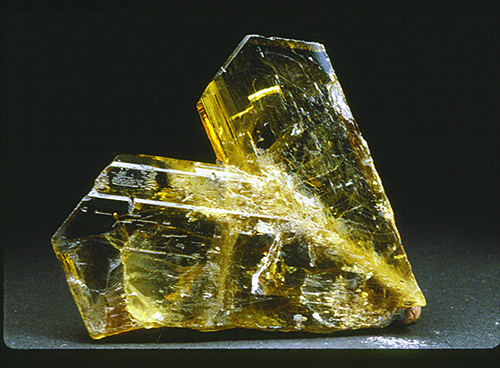
What is crystal twinning? This is seen when two types of crystals share the same lattice points. These specimens are accompanied by other species. Such clusters of minerals are called an aggregate of crystals. There are three general types of crystal twinning.
Before exploring crystal twinning, it’s important to know how to identify quartz and have an understanding of the quartz mineral group. Crystals can twin in parallel, or routine ways, involving two crystals, or as in complex twinning, several crystals. This is different than inclusions in quartz. To be considered as twins, the crystals must be in a fixed identifiable relationship to each other. As crystals grow in solution, individual ions of a mineral gather to form a crystal. This is an orderly geometric process that produces a pattern that results in an external crystal form.
Influences on Crystal Growth
Several factors influence how crystals grow, one being the direction of flow of the solution. This direction brings ions in contact with the growing crystal from a path that can influence growth. Such direction causes ions to accumulate on the side that receives the flow. This development can affect the orderly process of crystallization.
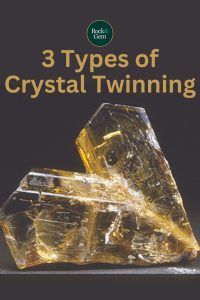
Sometimes, as the ions move to take a position in the crystal lattice, one ion may not quite fit right, appearing slightly offset. This occurrence is not enough to disturb the lattice structure but can affect later arriving ions.
Under rapid crystal growth, the next arriving ions attach to the slightly offset ion. When this happens, this offset results in a second crystal that grows in a different direction determined by the orderly rules of crystal growth.
The original crystal continues to grow during this time and so does the second attached crystal. This results in two crystals sharing a common boundary, or face, and a singular lattice.
The crystals attach at a predictable angle to each other. We can measure that angle to prove the pair of crystals is twinned. Specimens with such crystal structures are called contact twins, which is just one of several types of crystal twinning. Contact twins involve two crystals, while more complex twins involve several.
Crystal Angles
Crystal twins share a lattice and a face, giving a flattened look. The key to a twin is the distinct, exact angle between the two crystals, called the reentrant angle.
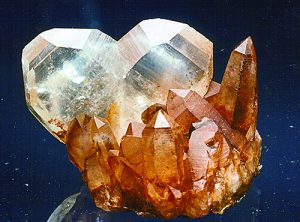
In contact twins, the reentrant angle appears as a ‘V’ notch that can range from barely visible to a wide-open span. This often makes the two crystals look like rabbit ears. The reentrant angle is always the same degree of separation.
This is critical to identifying a twin because there can be many “paired” crystals that look like contact twins. Unless the angle between the two quartz crystals is 84 degrees, they are not twinned.
This type of quartz twin is called a Japanese law twin. Regardless of how many Japanese twins you examine, there is a constancy of that angle. Other species twin with different reentrant angles, but each remains exactly constant to that particular species. Contact twins are common in quartz, gypsum, calcite and some feldspars like albite.
1. Types of Crystal Twinning – Penetration Twins
A second twin form of minerals is penetration twins. Simply described, penetration twins are two crystals of the same mineral that look as if they have been shoved together.
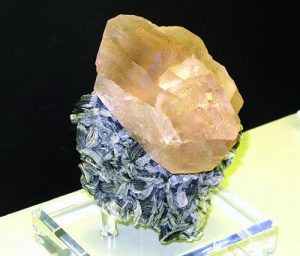
BOB JONES
Penetration twins occur when one crystal starts to develop, and a second crystal starts to grow inside the first as ions offset along an axis of the first crystal.
The second crystal grows at a different angle, determined by the direction of the first crystal axis. The result is one crystal resides within another crystal with the corners of the second crystal protruding from the center of each host crystal’s face.
This formation is prevalent in cubes of fluorite as well as pyrite. Note both these species are in the isometric or cubic crystal system, which commonly develops penetration twins.
Isometric Crystals
Isometric crystals also form octahedral crystals. Why is this important to note? Because the two cubic crystals in a penetration twin share a common octahedral axis as part of a valid twin formation.
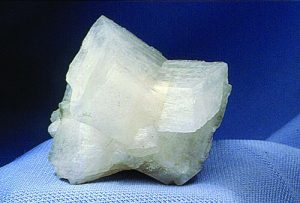
Staurolite, a monoclinic crystal form, can exhibit a perfect cross twin. Again, a common axis has to be shared for this to be a real cross and twin. In this formation, the same mineral forms another twin when one crystal is at a diagonal 60-degree axis of the host crystal.
Penetration twins can be visualized as one crystal mysteriously passing through another. Mother Nature is mysterious but not magical. Penetration twins are a matter of ions in geometry.
A spinel twin crystal, whether it is spinel, copper, sphalerite, or other cubic minerals, has to appear as an octahedron crystal cut in half. One half of the octahedron is rotated 180 degrees and re-attached to the other half. This process forms two very distinctive angular terminations at opposite ends of the crystal. It creates a visible shallow contact boundary running the length of the twin.
2. Types of Crystal Twinning – Cyclical Twins
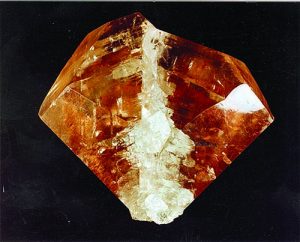
One of the most beautiful types of crystal twinning is cyclical twins. They are part of the polysynthetic group of twins. Cyclical twins require as many as six, or eight, crystals to join a flat-sided round donut-like shape. In some cases like aragonite, the cyclical twin has no doughnut hole. Others, like chrysoberyl, have a center hole the crystals twin around.
Cyclical twins only form in the hexagonal, tetragonal or orthorhombic systems. This information sometimes helps identify an unknown mineral.
Cyclical twins develop when several crystals share axes and faces during growth. They attach side by side as each pair forms at an angle to its neighbor resulting in a complete link to form a rounded or cyclical crystal twin.
3. Types of Crystal Twinning – Polysynthetic Twins
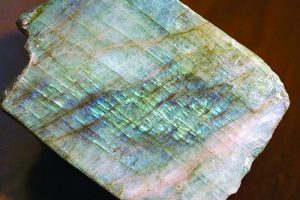
Cyclical twins are part of the group known as polysynthetic twins, also known as repeating twins. In the feldspar family, polysynthetic twinning is common, but each crystal is hardly distinctive. Feldspars, such as labradorite and albite, are typically polysynthetic twins.
In these minerals, flat, wafer-thin crystals form side by side, alternating one against the other, resulting in a solid mass. The result is something substantial that a lapidary can use. The beauty of this twinning is that the piece acts as a diffraction, so its component colors are visible. This subtle rainbow effect is referred to as the Schiller effect.
The Schiller Effect
The most fantastic use of feldspars I’ve seen with a Schiller effect resided within the Kremlin. The grounds behind the Kremlin walls feature a riot of flowers in huge planters with large blocks of stone forming low retaining walls.
These blocks caught my eye because each was composed of lapidary gem material. One wall was sensational, as it featured huge blocks of polished labradorite that shimmered in the sun. Unfortunately, my camera was “borrowed” by security during our visit.
Crystal Habit Awareness
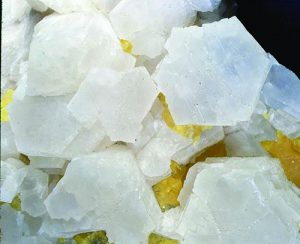
One of the real joys of collecting minerals is to be familiar with crystal habits. Not only to recognize but to collect crystals that are a bit unusual. Knowing ‘what’ and ‘why’ such twin crystals form is always a job, but highly rewarding. The more effort you put into learning about and collecting twinned crystals, the more enjoyable your collection will be.
Just a word of caution: Be cautious of crystals that look similar but are not twinned. Crystals that grow parallel, or jut in an angle resembling rabbit ears, may not be twinned. These are things you’ll learn to identify as you develop an interest in twinned crystals.
This story about types of crystal twinning previously appeared in Rock & Gem magazine. Click here to subscribe! Story by Bob Jones.















